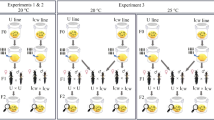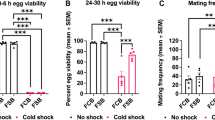Abstract
A family composed solely of daughters was produced by a pair of milkweed bugs, Spilostethus hospes (Hemiptera: Lygaeidae). The sex ratio among the offspring of the daughters was significantly female-biased, indicating that sex ratio distortion is heritable. The following results suggest that sex ratio distortion is caused by a maternally inherited, male-killing bacterium: females transmitted sex ratio distortion but males did not, egg hatch among pairs expressing sex ratio distortion was half that observed in pairs with unbiased offspring sex ratio, and pairs expressing sex ratio distortion converted to unbiased offspring sex ratio following tetracycline treatment. Successful selection for a highly female-biased sex ratio suggests that there is resistance to sex ratio distortion. Vertical transmission was incomplete and considerably reduced among females that underwent a forced delay in reproduction at cool temperatures analogous to an overwintering phase of the life cycle. An attempt to transfer bacteria horizontally by forcing early instars from a nonhost line to cannibalize host eggs was unsuccessful. With incomplete vertical transmission and no horizontal transmission, the bacterium presumably promotes its existence by boosting the reproductive success of host females, a possibility which remains to be investigated.
Similar content being viewed by others
Article PDF
References
Bull, J J. 1983. Evolution of Sex Determining Mechanisms. Benjamin/Cummings, Menlo Park CA.
Cosmides, L M, and Tooby, J. 1981. Cytoplasmic inheritance and intragenomic conflict. J Theor Biol, 89, 83–129.
Dingle, H. 1968. Life history and population consequences of density, photoperiod, and temperature in a migrant insect, the milkweed bug, Oncopeltus. Am Nat, 102, 149–163.
Dingle, H. 1978. Migration and diapause in tropical, temperate and island milkweed bugs. In: Dingle, H (ed.) The Evolution of Insect Migration and Diapause, pp. 254–276. Springer, New York.
Ebbert, M A. 1991. The interaction phenotype in the Drosophila willistoni-spiroplasma symbiosis. Evolution, 45, 971–988.
Ebbert, M A. 1992. Endosymbiotic sex ratio distorters in insects and mites. In: Wrensch, D. L. and Ebbert, M. A (eds) Evolution and Diversity of Sex Ratio in Haplodip-loid Insects and Mites, pp. 150–191. Chapman and Hall, New York.
Ebbert, M A. 1995. Variable effects of crowding on Drosophila hosts of male-lethal and non-male-lethal spiroplasmas in laboratory populations. Heredity, 74, 227–240.
Eberhard, W G. 1980. Evolutionary consequences of intracellular organelle competition. Q Rev Biol, 55, 231–249.
Gherna, R L, Werren, J H, Weisburg, W, Cote, R, Woese, C R, Mandelco, L, and Brenner, D J. 1991. Arsenophus nasoniae gen.-nov., sp.-nov., the causative agent of the son killer trait in the parasitic wasp Nasonia vitripennis. Int J Syst Bact, 41, 563–565.
Hoffmann, A A, Turelli, M, and Simmons, G M. 1986. Unidirectional incompatibility between populations of Drosophila simulans. Evolution, 40, 692–701.
Holloway, G J. 1984. An analysis of inherited factors affecting the sex ratio in the rice weevil, Sitophilus oryzae L. Heredity, 55, 145–150.
Hurst, G D D, and Majerus, M E N. 1992. Why do maternally inherited microorganisms kill males? Heredity, 71, 81–95.
Hurst, L D. 1991. The incidences and evolution of cytoplasmic male killers. Proc R Soc B, 244, 91–99.
Hurst, L D. 1992. Intragenomic conflict as an evolutionary force. Proc R Soc B, 248, 135–140.
Hurst, L D. 1993. The incidences, mechanisms and evolution of cytoplasmic sex ratio distorters in animals. Biol Rev, 68, 121–193.
Hurst, L D, and Vollrath, F. 1992. Sex-ratio adjustment in solitary and social spiders. Trends Ecol Evol, 7, 326–327.
Lamb, R Y, and Willey, R B. 1987. Cytological mechanisms of thelytokous parthenogenesis in insects. Genome, 29, 367–369.
Legrand, J J, Legrand-Hamelin, E, and Juchault, P. 1987. Sex determination in Crustacea. Biol Rev, 62, 439–470.
Leslie, J F. 1984. A “sex-ratio” condition in Oncopeltus fasciatus. J Hered, 75, 260–264.
Lyttle, T W. 1991. Segregation distorters. Ann Rev Genet, 25, 511–557.
Ralph, C P. 1977. Effect of host plant density on populations of a specialized, seed sucking bug, Oncopeltus fasciatus. Ecology, 58, 799–809.
Rigaud, T, and Juchault, P. 1992. Genetic control of the vertical transmission of a cytoplasmic sex factor in Armadillidium vulgare(Latr.) (Crustacea, Oniscidea). Heredity, 68, 47–52.
Sauer, D, and Feir, D. 1973. Studies on natural populations of Oncopeltus fasciatus (Dallas), the large milk weed bug. Am Midl Nat, 90, 13–37.
Skinner, S W. 1985. Son-killer: a third extrachromosomal factor affecting the sex ratio in the parasitoid wasp, Nasonia (= Mormoniella) vitripennis. Genetics, 109, 745–759.
Stouthamer, R, Luck, R F, and Hamilton, W S. 1990. Antibiotics cause parthenogenetic Trichogramma (Hymenoptera/Trichogrammatidae) to revert to sex. Proc Natl Acad Sci USA, 87, 2424–2427.
Thangavelu, K. 1978. Some notes on the ecology of three milkweed bugs in India (Heteroptera: Lygaeidae). J Nat Hist, 12, 641–647.
Uyenoyama, M K, and Feldman, M W. 1978. The genetics of sex ratio distortion by cytoplasmic infection under maternal and contagious transmission: an epidemiological study. Theor Pop Biol, 14, 471–497.
Vulinec, K. 1990. Aggregation by insects as a defense. In: Evans, D. L. and Schmidt, J. O (eds) Insect Defenses: Adaptive Mechanisms and Strategies of Prey and Predators, pp. 251–277. State University of New York Press, Albany, NY.
Werren, J H. 1987. The coevolution of autosomal and cytoplasmic sex ratio factors. Theor Biol, 124, 317–334.
Willamson, D L, and Poulson, D F. 1979. Sex ratio organisms (spiroplasmas) of Drosophila. In: Whitcomb, R. F. and Tully, J. G (eds) The Mycoplasmas, vol. 3, pp. 175–208. Academic Press, New York.
Wrensch, D L, and Ebbert, M A. (eds) 1992. Evolution and Diversity of Sex Ratio in Haplodiploid Insects and Mites. Chapman and Hall, New York.
Zchori-Fein, E, Rousch, R T, and Hunter, M S. 1992. Male production by antibiotic treatment in Encarsia formosa (Hymenoptera: Aphelinidae), an asexual species. Experientia, 48, 102–105.
Author information
Authors and Affiliations
Rights and permissions
About this article
Cite this article
Groeters, F. Maternally inherited sex ratio distortion as a result of a male-killing agent in Spilostethus hospes (Hemiptera: Lygaeidae). Heredity 77, 201–208 (1996). https://doi.org/10.1038/hdy.1996.125
Received:
Issue date:
DOI: https://doi.org/10.1038/hdy.1996.125



